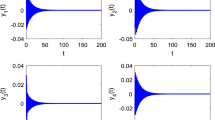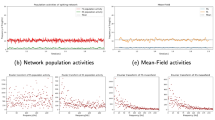Abstract
Previous experimental work has shown that the firing rate of multiple time-scales of adaptation for single rat neocortical pyramidal neurons is consistent with fractional-order differentiation, and the fractional-order neuronal models depict the firing rate of neurons more verifiably than other models do. For this reason, the dynamic characteristics of the fractional-order Hindmarsh–Rose (HR) neuronal model were here investigated. The results showed several obvious differences in dynamic characteristic between the fractional-order HR neuronal model and an integer-ordered model. First, the fractional-order HR neuronal model displayed different firing modes (chaotic firing and periodic firing) as the fractional order changed when other parameters remained the same as in the integer-order model. However, only one firing mode is displayed in integer-order models with the same parameters. The fractional order is the key to determining the firing mode. Second, the Hopf bifurcation point of this fractional-order model, from the resting state to periodic firing, was found to be larger than that of the integer-order model. Third, for the state of periodically firing of fractional-order and integer-order HR neuron model, the firing frequency of the fractional-order neuronal model was greater than that of the integer-order model, and when the fractional order of the model decreased, the firing frequency increased.
















Similar content being viewed by others
References
Adomian G (1990) A review of the decomposition method and some recent result for nonlinear equation. Math Comput Model 13(7):17–43
Ahmad W, Sprott JC (2003) Chaos in fractional-order autonomous nonlinear systems. Chaos Soliton Fract 16:339–351
Ahmed E, El-Sayed AMA, Elsaka HAA (2007) Equilibrium points, stability and numerical solutions of fractional-order predator-prey and rabies models. Math Anal Appl 325(1):542–553
Charef A, Sun HH, Tsao YY (1992) Fractal system as represented by singularity function. IEEE Trans Automat Contr 37(9):1465–1470
Diethelm K, Ford NJ, Freed AD (2002) A predictor–corrector approach for the numerical solution of Fractional differential equations. Nonlinear Dyn 29:3–22
Duan L, Fan D, Lu Q (2013) Hopf bifurcation and bursting synchronization in an excitable systems with chemical delayed coupling. Cogn Neurodyn 7(4):341–349
Guang-jun Z, Jian-xue X (2005) Stochastic resonance induced by novel random transitions of motion of FitzHugh-Nagumo neuron model. Chaos Solitons Fractals 23(4):1439–1449
Hong-jie Y, Jian-hua P (2005) Chaotic control of the Hindmarsh–Rose model. Acta Biophys Sin 21(4):295–300 (in Chinese)
Ivo Petráš (2011) Fractional-order nonlinear systems. High Education Press, p 1–3
Li CP, Peng GJ (2004) Chaos in Chen’s system with a fractional order. Chaos Solitons Fractals 22(2):443–450
Liu Y (2010) Dynamical characteristics of the fractional-order model neuron and its synchronization[D].Xi’an: Xi’an Jiao tong University (in Chinese)
Lundstrom BN, Higgs MH, Spain WJ, Fairhall AL (2008) Fractional differentiation by neocortical pyramidal neurons. Nat Neurosci 1(11):1335–1342
Magin R (2004) Fractional calculus in bioengineering. Begell House, Inc., Redding
Mandelbrot BB (1967) Some noises with 1/f spectrum, a bridge between direct current and white noise. IEEE Trans Inf Theory 13:289–298
Perc M (2005) Spatial coherence resonance in excitable media. Phys Rev E 72:016207
Perc M, Marhl M (2005) Amplification of information transfer in excitable systems that reside in a steady state near a bifurcation point to complex oscillatory behavior. Phys Rev E 71:026229
Perc M, Marhl M (2007) Noise-induced spatial dynamics in the presence of memory loss. Phys A 375(1):72–80
Podlubny I (1999) Fractional Differentical Equations. Academic Press, San Diego. CA, p 18
Sun X, Lei J, Perc M, Kurths J, Chen G (2011) Burst synchronization transitions in a neuronal network of subnetworks. Chaos 21:016110
Tavazoei MS, Haeri M (2007) Unreliability of frequency-domain approximation in recognising chaos in fractional-order systems. IET Signal Process 1(4):171–181
Wang Q, Perc M, Duan Z, Chen G (2011a) Synchronization transitions on scale-free neuronal networks due to finite information transmission delays. Phys Rev E 80:026206
Wang Q, Chen G, Perc M (2011b) Synchronous bursts on scale-free neuronal networks with attractive and repulsive coupling. PLoS One 6:e15851
Wang H, Wang Q, Qishao L, Zheng Y (2013) Equilibrium analysis and phase synchronization of two coupled HR neurons with gap junction. Cogn Neurodyn 7(2):121–131
Yamada Y, Kashimori Y (2013) Neural mechanism of dynamic responses of neurons in inferior temporal cortex in face perception. Cogn Neurodyn 7(1):23–38
Yang ZQ, Lu QS, Li L (2006) The genesis of period-adding bursting without bursting-chaos in the chay mode. Chaos Soliton Fractals 27:689–697
Yong L, Yong X (2010) Dynamical characteristics of the fractional-order FitzHugh-Nagumo model neuron and its synchronization. Acta Phys Sin 59(3):2417–2455 (in Chinese)
Zhang J-H, Qin P-P, Raisch J, Wang R-B (2013) Predictive modeling of human operator cognitive state via sparse and robust support vector machines. Cogn Neurodyn 7(5):40–395
Acknowledgments
The authors would like to thank the National Science Foundation under Grant (10872156, 81071150,10972170), Shaanxi Province Science Foundation under (2007014, 2012JM8035) and the Chinese Post-doctorate Foundation under 20080430203, all of which supported the work reported in this paper.
Author information
Authors and Affiliations
Corresponding author
Rights and permissions
About this article
Cite this article
Jun, D., Guang-jun, Z., Yong, X. et al. Dynamic behavior analysis of fractional-order Hindmarsh–Rose neuronal model. Cogn Neurodyn 8, 167–175 (2014). https://doi.org/10.1007/s11571-013-9273-x
Received:
Revised:
Accepted:
Published:
Issue Date:
DOI: https://doi.org/10.1007/s11571-013-9273-x




